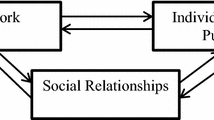Abstract
It was hypothesized that members of an older cohort of seriously mentally ill community mental health clients would develop stronger alliances with intensive case managers. Eighty-six clients participating in a study of case management services completed a measure of working alliance and structured interviews. It was found that older cohort clients, those age 45 or older, showed much stronger alliances with their case managers than younger clients.
Similar content being viewed by others
References
Abramson, N. S. (1986). Continuum of care for the chronically mentally ill elderly. In Abramson, N. S., Quam, J. K., & Wasow, M. (Eds.).The elderly and chronic mental illness. New directions for mental health services 29. San Francisco: Jossey Bass.
Atchley, R. C. (1989). A continuity theory of normal aging.The Gerontologist, 29(2), 183–190.
Bachrach, L. L. (1980). The young adult chronic psychiatric patient in an era of deinstitutionalization.American Journal of Public Health, 74, 382–384.
Belcher, J. R. (1988). Are jails replacing the mental health system for the homeless mentally ill?Community Mental Health Journal, 24, 185–195.
Benda, B. B. (1991). Undomiciled: A study of drifters, other homeless persons, their problems and service utilization.Psychosocial Rehabilitation Journal, 14, 39–68.
Bond, G. R., Miller, L. D., Krumwied, R., & Ward, R. S. (1988). Assertive case management in three CMHC's: A controlled study.Hospital and Community Psychiatry, 39, 411–418.
Bordin, E. S. (1979). The generalizability of the psychoanalytic concept of the working alliance.Psychotherapy, 16, 252–260.
Butler, R. N., Lewis, M., Sunderland, T. (1991).Aging and mental health: Positive psychosocial and biomedical approaches (Fourth edition). New York: Merrill.
Chamberlain, R., & Rapp, C. (1991). A decade of case management: A methodological review of outcome research.Community Mental Health Journal, 27, 171–188.
Cohen, C. I. (1993). Poverty and the course of schizophrenia: Implications for research and policy.Hospital and Community Psychiatry, 44, 951–957.
Cohen, C. I., & Kochanowicz, N. (1989). Schizophrenia and social network patterns: A survey of black inner-city outpatients.Community Mental Health Journal, 25(3), 197–207.
Drake, R. E., & Sederer, L. I. (1986). The adverse effects of intensive treatment of chronic schizophrenia.Comprehensive Psychiatry, 27, 313–326.
Endicott, J., Spitzer, R., Fleiss, J., & Cohen, J. (1976). The global assessment scale.Archives of General Psychiatry, 33, 766–771.
Frank, A. G., & Gunderson, J. G. (1990). The role of the therapeutic alliance in the treatment of schizophrenia.Archives of General Psychiatry, 47, 228–236.
Gelberg, L., Linn, L. S., & Leake, B. D. (1988). Mental health, alcohol and drug use, and criminal history among homeless adults.American Journal of Psychiatry, 145, 191–196.
Goering, P., & Stylianos, S. (1988). Exploring the helping relationship between schizophrenic client and rehabilitation therapist.American Journal of Orthopsychiatry, 58, 271–279.
Hodge, M., & Draine, J. (1993). Developing support through case management services. In Flexer, R. W., & Solomon, P. S. (Eds.)Psychiatric rehabilitation in practice. Boston: Andover Medical Publishers.
Hovarth, A., & Greenberg, L. (1989). Development and validation of the working alliance inventory.Journal of Consulting and Clinical Psychology, 36, 223–233.
Kiesler, C. A., & Sibulkin, A. E. (1987).Mental hospitalization: Myths and facts about a national crisis. Newbury Park, CA: Sage.
Lamb, H.R. (1992). Deinstitutionalization in the nineties. In Lamb, H. R., Bachrach, L. L., & Kass, F. I. (Eds.).Treating the homeless mentally ill. Washington, DC: American Psychiatric Association.
Lukoff, D., Liberman, R. P., & Neuchterlein, K. H. (1986). Symptom monitoring in the rehabilitation of schizophrenia patients.Schizophrenia Bulletin, 12, 578–602.
Norbeck, J. S. (1982). The use of social support in clinical practice.Journal of Psychosocial Nursing and Mental Health Services, 20, 22–29.
Overall, J., & Gorham, D. (1962). The brief psychiatric rating scale.Psychological Reports, 10, 799–812.
Pattison, E. M., & Pattison, M. L. (1981). Analysis of a schizophrenic psychosocial network.Schizophrenia Bulletin, 7, 135–142.
Pogrebin, M. R. & Poole, E. D. (1987). Deinstitutionalization and increased arrest rates among the mentally disordered.Journal of Psychiatry and Law, 15, 117–127.
Ralph, R., & Clary, B. (1992, October). The Working Alliance Inventory: Measuring the relationship between client and case manager. Presentation at the National Conference on State Mental Health Agencies Services Research. Baltimore, MD.
Rubin, A. (1992). Is case management effective for people with serious mental illness? A research review.Health and Social Work, 17, 138–150.
Ryan, M. C., & Austin, A. G. (1989). Social supports and social networks in the aged.Image: The Journal of Nursing Scholarship, 21(3), 176–180.
Solomon, P. (1992). The efficacy of case management services for severely mentally disabled clients.Community Mental Health Journal, 28, 163–180.
Stein, L. I., & Test, M. A. (1980). Alternatives to mental hospital treatment I: Conceptual model, treatment program, and clinical evaluation.Archives of General Psychiatry, 37, 392–397.
Sullivan, P. F., Bulik, C. M., Forman, S. D., & Mezzich, J. E. (1993). Characteristics of repeat users of a psychiatric emergency service.Hospital and Community Psychiatry, 44, 376–380.
Surles, R. C., & McGurrin, M. C. (1987). Increased use of psychiatric emergency services by young chronic mentally ill patients.Hospital and Community Psychiatry, 38, 401–403.
Talbott, J. A. (1983). A special population: The elderly deinstitutionalized chronically mentally ill patient.Psychiatric Quarterly, 55(2/3), 90–105.
Winogrond, I. R. (1986). Aftercare: A patient-centered model of advocacy for relocated mental health patients. In Abramson, N. S., Quam, J. K., & Wasow, M. (Eds.).The elderly and chronic mental illness. New directions for mental health services 29. San Francisco: Jossey Bass.
Author information
Authors and Affiliations
Additional information
This research is funded by NIMH/SAMHSA grant R18MH46082.
Rights and permissions
About this article
Cite this article
Draine, J., Solomon, P. Case manager alliance with clients in an older cohort. Community Ment Health J 32, 125–134 (1996). https://doi.org/10.1007/BF02249750
Issue Date:
DOI: https://doi.org/10.1007/BF02249750




